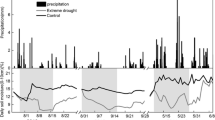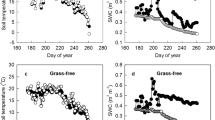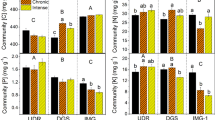Abstract
Predictions of future climate over the next 100 years show that the frequency of long periods of droughts in summer will increase in the Netherlands. This study investigated the effect of 14 annually repeated droughts on soil respiration at a Dutch heathland. Field measurements of total soil respiration (RS) and microbial respiration (RH) were modeled to determine annual C losses and to derive root respiration (RA) C losses. The application of repeated droughts resulted in suppression of the total soil C loss from 392 to 332 g C m−2 year−1 in 2010–2011 and from 427 to 358 g C m−2 year−1 in 2011–2012. The RH was the greatest contributor to heathland soil C loss (74–76%) and this was suppressed when directly exposed to drought conditions, although not significantly reduced on an annual basis. Annual RA was suppressed by 42% (2010–2011) and 45% (2011–2012) under repeated drought, indicating there was a greater effect of the repeated annual drought in roots than in microbes. Field observations of photosynthesis (PG) showed paradoxical results, with significantly greater ecosystem PG on the drought treatment than the control treatment. Inclusion of plant activity (PG) as a variable did not improve the fit of the models used in this study. However, other changes in plant composition and structure, such as increasing moss cover on the drought treatment, were noted to have occurred during the 14 years of annually repeated drought and these long term trends may help explain the effects of climate change (drought) on soil processes.





Similar content being viewed by others
References
Bahn M, Reichstein M, Davidson EA, Grünzweig J, Jung M, Carbone MS, Epron D, Misson L, Nouvellon Y, Roupsard O, others . 2010a. Soil respiration at mean annual temperature predicts annual total across vegetation types and biomes. Biogeosciences 7(7):2147–57.
Bahn M, Janssens IA, Reichstein M, Smith P, Trumbore SE. 2010b. Soil respiration across scales: towards an integration of patterns and processes. New Phytol 186(2):292–6.
Beier C, Emmett BA, Tietema A, Schmidt IK, Penuelas J, Lang EK, Duce P, De Angelis P, Gorissen A, Estiarte M et al. 2009. Carbon and nitrogen balances for six shrublands across Europe. Glob Biogeochem Cycle 23:13.
Beier C, Emmett B, Gundersen P, Tietema A, Peñuelas J, Estiarte M, Gordon C, Gorissen A, Llorens L, Roda F, others . 2004. Novel approaches to study climate change effects on terrestrial ecosystems in the field: drought and passive nighttime warming. Ecosystems 7(6):583–97.
Blenkinsop S, Fowler HJ. 2007. Changes in European drought characteristics projected by the PRUDENCE regional climate models. Intl J Climatol 27:1595–610.
Burton AJ, Jarvey JC, Jarvi MP, Zak DR, Pregitzer KS. 2012. Chronic N deposition alters root respiration-tissue N relationship in northern hardwood forests. Glob Chang Biol 18(1):258–66.
Cable J, Ogle K, Williams D, Weltzin J, Huxman T, Ogle M, Williams K, Weltzin D, Huxman G, Huxman J, others . 2008. Soil texture drives responses of soil respiration to precipitation pulses in the sonoran desert: implications for climate change. Ecosystems 11(6):961–79.
Chaves MM, Pereira JS, Maroco J, Rodrigues ML, Ricardo CPP, Osório ML, Carvalho I, Faria T, Pinheiro C. 2002. How plants cope with water stress in the field? Photosynthesis and growth. Ann Bot 89(7):907–16.
Chaves MM, Maroco JP, Pereira JS. 2003. Understanding plant responses to drought—from genes to the whole plant. Funct Plant Biol 30(3):239–64.
Chen X, Post W, Norby R, Classen A. 2011. Modeling soil respiration and variations in source components using a multi-factor global climate change experiment. Clim Chang 107(3):459–80.
Dai A. 2011a. Characteristics and trends in various forms of the palmer drought severity index during 1900–2008. J Geophys Res 116:12115.
Dai A. 2011b. Drought under global warming: a review. Wiley interdisciplinary reviews. Clim Chang 2(1):45–65.
Davidson EA, Janssens IA. 2006. Temperature sensitivity of soil carbon decomposition and feedbacks to climate change. Nature 440(7081):165–73.
Davidson EA, Janssens IA, Luo Y. 2006. On the variability of respiration in terrestrial ecosystems: moving beyond Q10. Glob Chang Biol 12(2):154–64.
Díaz-Pinés E, Schindlbacher A, Pfeffer M, Jandl R, Zechmeister-Boltenstern S, Rubio A. 2010. Root trenching: a useful tool to estimate autotrophic soil respiration? A case study in an Austrian mountain forest. Eur J For Res 129(1):101–9.
Emmett BA, Beier C, Estiarte M, Tietema A, Kristensen HL, Williams D, Peñuelas J, Schmidt I, Sowerby A. 2004. The response of soil processes to climate change: results from manipulation studies of shrublands across an environmental gradient. Ecosystems 7(6):625–37.
Fog K. 1988. The effect of added nitrogen on the rate of decomposition of organic matter. Biol Rev 63(3):433–62.
Glime JM. 2007. Physiological ecology. In: Bryophyte ecology. Ebook sponsored by Michigan Technological University and the International Association of Bryologists, vol. 1. http://www.bryoecol.mtu.edu. Accessed 16 Oct 2012.
Gomez-Casanovas N, Matamala R, Cook DR, Gonzalez-Meler MA. 2012. Net ecosystem exchange modifies the relationship between the autotrophic and heterotrophic components of soil respiration with abiotic factors in prairie grasslands. Glob Chang Biol 18(8):2532–45.
Gorissen A, Tietema A, Joosten NN, Estiarte M, Peñuelas J, Sowerby A, Emmett BA, Beier C. 2004. Climate change affects carbon allocation to the soil in shrublands. Ecosystems 7(6):650–61.
Hanson PJ, Edwards NT, Garten CT, Andrews JA. 2000. Separating root and soil microbial contributions to soil respiration: a review of methods and observations. Biogeochemistry 48(1):115–46.
IPCC. 2007. Chapter 12: Europe. Parry ML, Canziani OF, Palutikof JP, and others, editors. In: Contribution of working group II to the fourth assessment report of the intergovernmental panel on climate change. Cambridge: Cambridge University Press.
Janssens IA, Lankreijer H, Matteucci G, Kowalski AS, Buchmann N, Epron D, Pilegaard K, Kutsch W, Longdoz B, Grunwald T, others . 2001. Productivity overshadows temperature in determining soil and ecosystem respiration across European forests. Glob Chang Biol 7(3):269–78.
Jassal RS, Black TA. 2006. Estimating heterotrophic and autotrophic soil respiration using small-area trenched plot technique: theory and practice. Agric For Meteorol 140(1–4):193–202.
Jensen KD, Beier C, Michelsen A, Emmett BA. 2003. Effects of experimental drought on microbial processes in two temperate heathlands at contrasting water conditions. Appl Soil Ecol 24(2):165–76.
Keenan TF, Davidson E, Moffat AM, Munger W, Richardson AD. 2012. Using model-data fusion to interpret past trends, and quantify uncertainties in future projections, of terrestrial ecosystem carbon cycling. Glob Chang Biol 18(8):2555–69.
Kopittke GR, van Loon EE, Tietema A, Asscheman D. 2013a. Soil respiration compartments on an aging managed heathland: identifying an appropriate empirical model for predictive purposes. Biogeosciences 10:3007–38.
Kopittke GR, Tietema A, van Loon EE, Kalbitz K. 2013b. The age of managed heathland communities: implications for carbon storage? Plant Soil 369:219–30.
Kopittke GR, Tietema A, Verstraten JM. 2012. Soil acidification occurs under ambient conditions but is retarded by repeated drought: results of a field-scale climate manipulation experiment. Sci Total Environ 439:332–42.
Larsen KS, Ibrom A, Beier C, Jonasson S, Michelsen A. 2007. Ecosystem respiration depends strongly on photosynthesis in a temperate health. Biogeochemistry 85(2):201–13.
Lawson CS, Ford MA, Mitchley J, Warren JM. 2004. The establishment of heathland vegetation on ex-arable land: the response of Calluna vulgaris to soil acidification. Biol Conserv 116(3):409–16. doi:10.1016/S0006-3207(03)00233-7.
Liu F, Stützel H. 2004. Biomass partitioning, specific leaf area, and water use efficiency of vegetable amaranth (amaranthus spp.) in response to drought stress. Sci Hortic 102(1):15–27.
Loidi J, Biurrun I, Campos JA, Garciá-Mijangos I, Herrera M. 2010. A biogeographical analysis of the European Atlantic lowland heathlands. J Veg Sci 21(5):832–42.
Maestre FT, Cortina J. 2003. Small-scale spatial variation in soil CO2 efflux in a mediterranean semiarid steppe. Appl Soil Ecol 23(3):199–209.
Medlyn BE, Duursma RA, Zeppel MJB. 2011. Forest productivity under climate change: a checklist for evaluating model studies. Wiley interdisciplinary reviews. Clim Chang 2(3):332–55.
Medlyn BE, Robinson AP, Clement R, McMurtrie RE. 2005. On the validation of models of forest CO2 exchange using eddy covariance data: some perils and pitfalls. Tree Physiol 25(7):839–57.
Metcalfe DB, Fisher RA, Wardle DA. 2011. Plant communities as drivers of soil respiration: pathways, mechanisms, and significance for global change. Biogeosciences 8(8):15–2047.
Michel P, Lee WG, During HJ, Cornelissen JHC. 2012. Species traits and their non-additive interactions control the water economy of bryophyte cushions. J Ecol 100(1):222–31.
Mikkelsen TN, Beier C, Jonasson S, Holmstrup M, Schmidt IK, Ambus P, Pilegaard K, Michelsen A, Albert K, Andresen LC et al. 2008. Experimental design of multifactor climate change experiments with elevated CO2, warming and drought: the CLIMAITE project. Funct Ecol 22(1):185–95.
Pedersen AR. 2011. HMR: Flux estimation with static chamber data. R package version 0.3.1.
Pedersen AR, Petersen SO, Schelde K. 2010. A comprehensive approach to soil-atmosphere trace-gas flux estimation with static chambers. Eur J Soil Sci 61(6):888–902.
Peñuelas J, Prieto P, Beier C, Cesaraccio C, De Angelis P, De Dato G, Emmett BA, Estiarte M, Garadnai J, Gorissen A, others. 2007. Response of plant species richness and primary productivity in shrublands along a north–south gradient in Europe to seven years of experimental warming and drought: reductions in primary productivity in the heat and drought year of 2003. Glob Chang Biol 13(12):2563–81.
Pinheiro JC, Bates DM. 2000. Mixed-effects models in S and S-plus. New York, NY: Springer.
R Development Core Team. 2008. R: A language and environment for statistical computing.
Raich JW, Schlesinger WH. 1992. The global carbon dioxide flux in soil respiration and its relationship to vegetation and climate. Tellus B 44(2):81–99.
Reichstein M, Rey A, Freibauer A, Tenhunen J, Valentini R, Banza J, Casals P, Cheng YF, Grunzweig JM, Irvine J, others . 2003. Modeling temporal and large-scale spatial variability of soil respiration from soil water availability, temperature and vegetation productivity indices. Glob Biogeochem Cycles 17(4):1104–19.
Rodrigues ML, Pacheco CMA, Chaves MM. 1995. Soil-plant water relations, root distribution and biomass partitioning in Lupinus albus L. under drought conditions. J Exp Bot 46(8):947–56.
Ryan MG, Law BE. 2005. Interpreting, measuring, and modeling soil respiration. Biogeochemistry 73(1):3–27.
Sanaullah M, Chabbi A, Rumpel C, Kuzyakov Y. 2012. Carbon allocation in grassland communities under drought stress followed by 14C pulse labeling. Soil Biol Biochem 55:132–9.
Selsted MB, van der Linden L, Ibrom A, Michelsen A, Larsen KS, Pedersen JK, Mikkelsen TN, Pilegaard K, Beier C, Ambus P. 2012. Soil respiration is stimulated by elevated CO2 and reduced by summer drought: three years of measurements in a multifactor ecosystem manipulation experiment in a temperate heathland (CLIMAITE). Glob Chang Biol 18(4):1216–30.
Sierra CA, Harmon ME, Thomann E, Perakis SS, Loescher HW. 2011. Amplification and dampening of soil respiration by changes in temperature variability. Biogeosciences 8(4):951–61.
Sowerby A, Emmett BA, Tietema A, Beier C. 2008. Contrasting effects of repeated summer drought on soil carbon efflux in hydric and mesic heathland soils. Glob Chang Biol 14(10):2388–404.
van der Molen MK, Dolman AJ, Ciais P, Eglin T, Gobron N, Law BE, Meir P, Peters W, Phillips OL, Reichstein M et al. 2011. Drought and ecosystem carbon cycling. Agric For Meteorol 151(7):765–73.
Wessel WW, Tietema A, Beier C, Emmett BA, Peñuelas J, Riis-Nielsen T. 2004. A qualitative ecosystem assessment for different shrublands in Western Europe under impact of climate change. Ecosystems 7(6):662–71.
Acknowledgments
This study was carried out and funded by European Commission under the FP7-Research Infrastructures Programme (Grant Agreement No. 227628) as a part of the Integrated Network on Climate Research Activities on Shrubland Ecosystems (INCREASE) project. The authors would like to thank Sharon Mason and Louise Andresen for their contributions to this paper, the University of Amsterdam (Universiteit van Amsterdam) for making this research possible and the Royal Netherlands Army (Koninklijke Landmacht) for access to the field site.
Author information
Authors and Affiliations
Corresponding author
Additional information
Author Contributions
GRK, AT, and DA conceived and designed the study and contributed to performing the research. GRK and EEVL analyzed data and (together with AT) wrote the paper.
Rights and permissions
About this article
Cite this article
Kopittke, G.R., Tietema, A., van Loon, E.E. et al. Fourteen Annually Repeated Droughts Suppressed Autotrophic Soil Respiration and Resulted in an Ecosystem Change. Ecosystems 17, 242–257 (2014). https://doi.org/10.1007/s10021-013-9720-x
Received:
Accepted:
Published:
Issue Date:
DOI: https://doi.org/10.1007/s10021-013-9720-x




